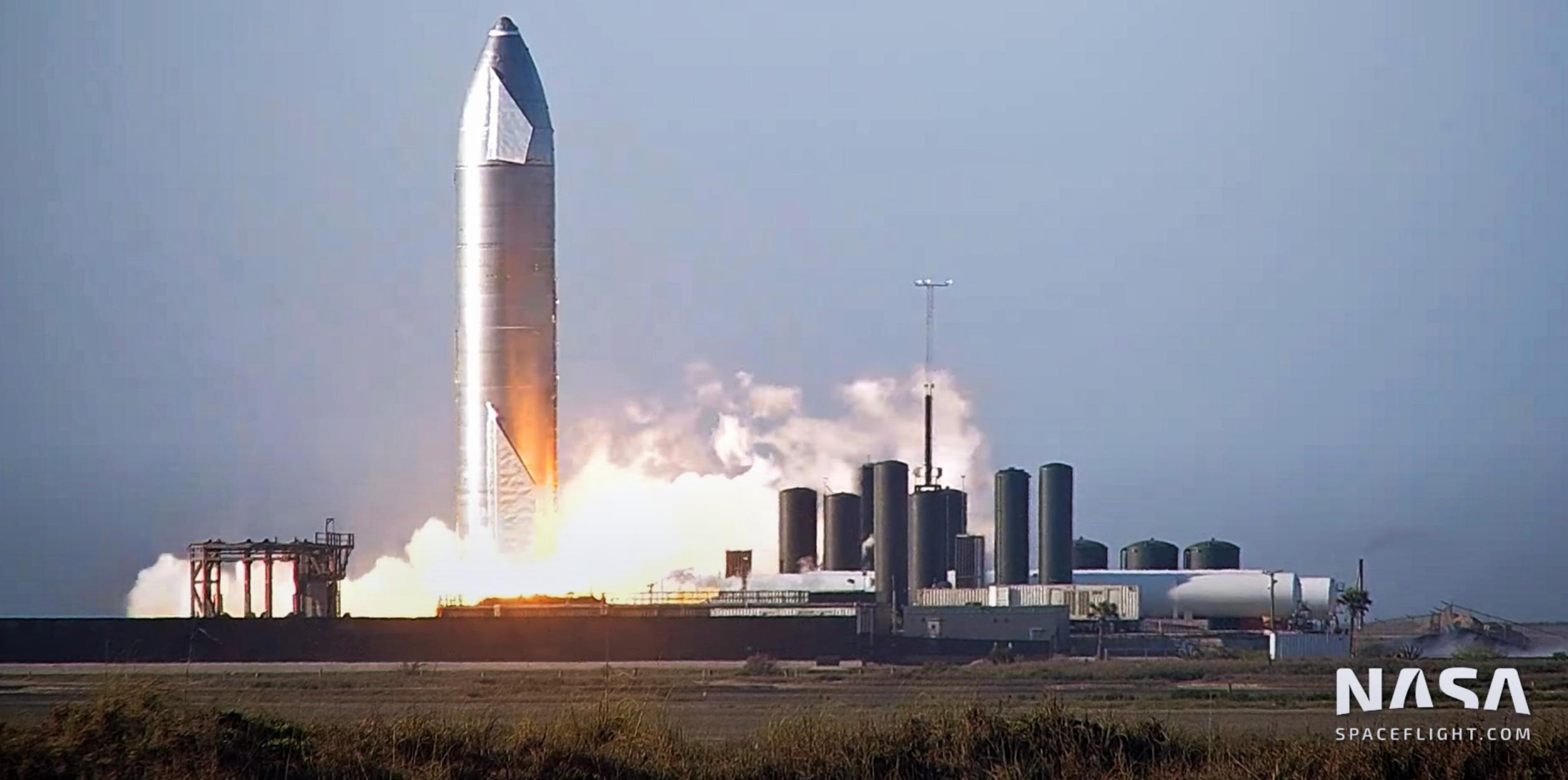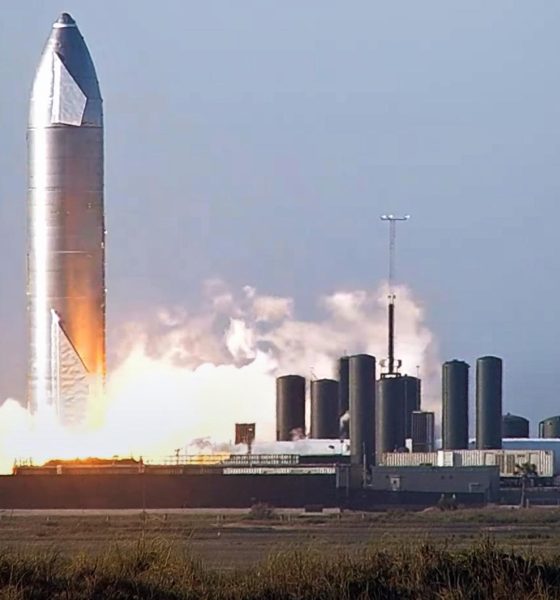

News
SpaceX aces Starship static fire days after NASA astronaut visit
Update: Around 9am CDT (UTC-5), SpaceX successfully fired up Starship serial number 11’s (SN11) three Raptor engines, completing the static fire test on the first try of the day and just two hours into in Monday’s eight-hour window.
As far as three-engine Starship static fires go, SN11’s Monday test was about as smooth and clean as they come, boding extremely well for a launch attempt as early as either Tuesday or Wednesday, according to Temporary Flight Restrictions (TFRs) filed with the FAA. With flight termination system (FTS) explosive charges already installed and an FAA license in hand, all that stands between Starship SN11 and flight is a deeper static fire review and the cooperation of local weather conditions. Stay tuned for updates!
A group of NASA astronauts appear to have taken an agency-sanctioned trip down to SpaceX’s Boca Chica Starship facilities, including a visit with a prototype scheduled to fire up and launch as early as this week.
Seemingly in lockstep with the accelerating pace of Starship production and testing, the frequency of NASA astronaut visits to SpaceX’s South Texas facilities has also seen an uptick over the last six or so months.
Back in 2019, SpaceX built Starhopper, performed numerous tests with early Raptor engine prototypes, and performed two untethered hops. With that success in hand, SpaceX turned its focus to Starship Mk1 and suffered an almost immediate failure during pressure testing, encouraging a series of rapid manufacturing upgrades largely completed in just a few months’ time.
In 2020, SpaceX pushed those new facilities to the limits while continuing major expansions. In 12 months, SpaceX built and tested five small ‘test tanks’ and six full Starship tank sections, performed almost a dozen Raptor static fires with that hardware, hopped two of those tanks (SN5 & SN6) to 150m, fully integrated the first full-height Starship (SN8), and nearly landed that vehicle after an otherwise flawless 12.5 km (7.8 mi) launch and descent.
Back in 2019, NASA inked its first monetary Starship contract with SpaceX, awarding $3M to prototype a coupling mechanism Starships will need to dock and refuel in space. In April 2020, NASA revealed that SpaceX – with its Starship launch vehicle – was one of three finalists selected to compete for a Human Landing System (HLS) Moon lander contract, providing the company $135M of the full $970M award to begin preliminary design and certification work.
Around five months later, a group of NASA astronauts made their first public visit to SpaceX’s Starship development hub in South Texas, overflying the factory and launch pad in training jets on a routine sortie out of Houston and Johnson Space Center. Days later, SpaceX won a $53M NASA “Tipping Point” contract to demonstrate large-scale cryogenic propellant transfer with a Starship prototype.
Ultimately, excluding rock-solid commercial crew and cargo partnerships, NASA’s relationship with SpaceX and the company’s Starship appears to be growing stronger every day. While it’s hard to say just how indicative of that growth the visible attention of NASA’s astronaut corps is, it’s worth taking note of what those same astronauts aren’t (publicly) overflying, visiting, and touring – namely factories, R&D facilities, or prototype hardware of HLS competitors Dynetics and Blue Origin.
Delayed by about a week, SpaceX is currently preparing to fire up its fourth full-size Starship prototype – SN11 – for the first time as early as Monday, March 22nd, 19 days after Starship SN10 briefly landed in one piece. SpaceX has filed temporary flight restrictions (TFRs) with the FAA for SN11’s 10 km (6.2 mi) launch debut from Tuesday through Friday, leaving plenty of opportunities for a launch this week if the rocket can successfully test its three Raptor engines by Wednesday.

News
Tesla Model Y Standard Long Range RWD launches in Europe
The update was announced by Tesla Europe & Middle East in a post on its official social media account on X.

Tesla has expanded the Model Y lineup in Europe with the introduction of the Standard Long Range RWD variant, which offers an impressive 657 km of WLTP range.
The update was announced by Tesla Europe & Middle East in a post on its official social media account on X.
Model Y Standard Long Range RWD Details
Tesla Europe & Middle East highlighted some of the Model Y Standard Long Range RWD’s most notable specs, from its 657 km of WLTP range to its 2,118 liters of cargo volume. More importantly, Tesla also noted that the newly released variant only consumes 12.7 kWh per 100 km, making it the most efficient Model Y to date.
The Model Y Standard provides a lower entry point for consumers who wish to enter the Tesla ecosystem at the lowest possible price. While the Model 3 Standard is still more affordable, some consumers might prefer the Model Y Standard due to its larger size and crossover form factor. The fact that the Model Y Standard is equipped with Tesla’s AI4 computer also makes it ready for FSD’s eventual rollout to the region.
Top Gear’s Model Y Standard review
Top Gear‘s recent review of the Tesla Model Y Standard highlighted some of the vehicle’s most notable features, such as its impressive real-world range, stellar infotainment system, and spacious interior. As per the publication, the Model Y Standard still retains a lot of what makes Tesla’s vehicles well-rounded, even if it’s been equipped with a simplified interior.
Top Gear compared the Model Y Standard to its rivals in the same segment. “The introduction of the Standard trim brings the Model Y in line with the entry price of most of its closest competition. In fact, it’s actually cheaper than a Peugeot e-3008 and costs £5k less than an entry-level Audi Q4 e-tron. It also makes the Ford Mustang Mach-E look a little short with its higher entry price and worse range,” the publication wrote.
Elon Musk
Elon Musk’s xAI bets $20B on Mississippi with 2GW AI data center project
The project is expected to create hundreds of permanent jobs, dramatically expand xAI’s computing capacity, and further cement the Mid-South as a growing hub for AI infrastructure.

Elon Musk’s xAI plans to pour more than $20 billion into a massive new data center campus in Southaven, Mississippi, marking the largest single economic development project in the state’s history.
The project is expected to create hundreds of permanent jobs, dramatically expand xAI’s computing capacity, and further cement the Mid-South as a growing hub for AI infrastructure.
xAI goes MACROHARDRR in Mississippi
xAI has acquired and is retrofitting an existing facility in Southaven to serve as a new data center, which will be known as “MACROHARDRR.” The site sits near a recently acquired power plant and close to one of xAI’s existing data centers in Tennessee, creating a regional cluster designed to support large-scale AI training and inference.
Once completed, the Southaven facility is expected to push the company’s total computing capacity to nearly 2 GW, placing it among the most powerful AI compute installations globally. The data center is scheduled to begin operations in February 2026.
Gov. Tate Reeves shared his optimism about the project in a press release. “This record-shattering $20 billion investment is an amazing start to what is sure to be another incredible year for economic development in Mississippi. Today, Elon Musk is bringing xAI to DeSoto County, a project that will transform the region and bring amazing opportunities to its residents for generations. This is the largest economic development project in Mississippi’s history,” he said.
xAI’s broader AI ambitions
To secure the investment, the Mississippi Development Authority approved xAI for its Data Center Incentive program, which provides sales and use tax exemptions on eligible computing hardware and software. The City of Southaven and DeSoto County are also supporting the project through fee-in-lieu agreements aimed at accelerating development timelines and reducing upfront costs.
Founded in 2023 by Elon Musk, xAI develops advanced artificial intelligence systems focused on large-scale reasoning and generative applications. Its flagship product, Grok, is integrated with the social media platform X, alongside a growing suite of APIs for image generation, voice, and autonomous agents, including offerings tailored for government use.
Elon Musk highlighted xAi’s growth and momentum in a comment about the matter. “xAI is scaling at an immeasurable pace — we are building our third massive data center in the greater Memphis area. MACROHARDRR pushes our Colossus training compute to ~2GW – by far the most powerful AI system on Earth. This is insane execution speed by xAI and the state of Mississippi. We are grateful to Governor Reeves for his support of building xAI at warp speed,” Musk said.
Elon Musk
Tesla AI Head says future FSD feature has already partially shipped

Tesla’s Head of AI, Ashok Elluswamy, says that something that was expected with version 14.3 of the company’s Full Self-Driving platform has already partially shipped with the current build of version 14.2.
Tesla and CEO Elon Musk have teased on several occasions that reasoning will be a big piece of future Full Self-Driving builds, helping bring forth the “sentient” narrative that the company has pushed for these more advanced FSD versions.
Back in October on the Q3 Earnings Call, Musk said:
“With reasoning, it’s literally going to think about which parking spot to pick. It’ll drop you off at the entrance of the store, then go find a parking spot. It’s going to spot empty spots much better than a human. It’s going to use reasoning to solve things.”
Musk said in the same month:
“By v14.3, your car will feel like it is sentient.”
Amazingly, Tesla Full Self-Driving v14.2.2.2, which is the most recent iteration released, is very close to this sentient feeling. However, there are more things that need to be improved, and logic appears to be in the future plans to help with decision-making in general, alongside other refinements and features.
On Thursday evening, Elluswamy revealed that some of the reasoning features have already been rolled out, confirming that it has been added to navigation route changes during construction, as well as with parking options.
He added that “more and more reasoning will ship in Q1.”
🚨 Tesla’s Ashok Elluswamy reveals Nav decisions when encountering construction and parking options contain “some elements of reasoning”
More uses of reasoning will be shipped later this quarter, a big tidbit of info as we wait v14.3 https://t.co/jty8llgsKM
— TESLARATI (@Teslarati) January 9, 2026
Interestingly, parking improvements were hinted at being added in the initial rollout of v14.2 several months ago. These had not rolled out to vehicles quite yet, as they were listed under the future improvements portion of the release notes, but it appears things have already started to make their way to cars in a limited fashion.
Tesla Full Self-Driving v14.2 – Full Review, the Good and the Bad
As reasoning is more involved in more of the Full Self-Driving suite, it is likely we will see cars make better decisions in terms of routing and navigation, which is a big complaint of many owners (including me).
Additionally, the operation as a whole should be smoother and more comfortable to owners, which is hard to believe considering how good it is already. Nevertheless, there are absolutely improvements that need to be made before Tesla can introduce completely unsupervised FSD.








